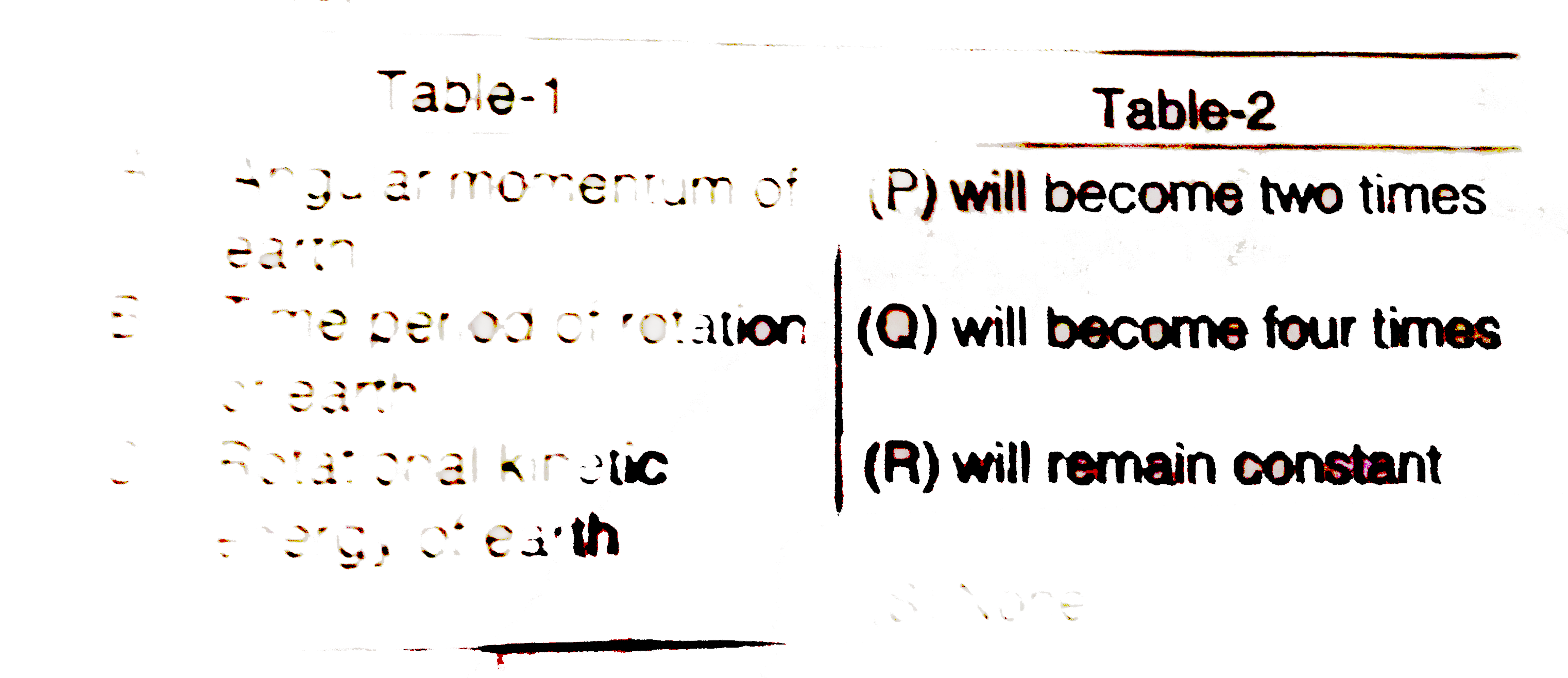If radius of the earth contracts to half of its present value without change in its mass, what will be the new duration of the day?
To solve the problem of determining the new duration of the day if the radius of the Earth contracts to half of its present value without a change in its mass, we can follow these steps:
1. Understanding Angular Momentum:
The angular momentum (L) of a rotating body is given by the formula:
L=Iω
where I is the moment of inertia and ω is the angular velocity.
2. Calculate Present Angular Momentum (L1):
For a solid sphere like Earth, the moment of inertia I is given by:
I=25mR2
where m is the mass of the Earth and R is its radius. Therefore, the present angular momentum L1 can be expressed as:
L1=Iω=25mR2ω
3. Calculate New Angular Momentum (L2):
If the radius contracts to half, the new radius R′=R2. The moment of inertia with the new radius becomes:
I′=25m(R2)2=25mR24=110mR2
The new angular momentum L2 is:
L2=I′ω′=110mR2ω′
4. Conservation of Angular Momentum:
Since there is no external torque acting on the Earth, angular momentum is conserved:
L1=L2
Thus,
25mR2ω=110mR2ω′
5. Simplifying the Equation:
We can cancel m and R2 from both sides:
25ω=110ω′
Rearranging gives us:
ω′=4ω
6. Relating Angular Velocity to Time Period:
The relationship between angular velocity ω and the time period T is given by:
ω=2πT
Therefore, the new angular velocity ω′ can be expressed in terms of the new time period T′:
ω′=2πT′
7. Setting Up the Equation:
Since ω′=4ω, we can write:
2πT′=4⋅2πT
This simplifies to:
1T′=4⋅1T
Thus,
T′=T4
8. Calculating the New Duration of the Day:
The present duration of the day T is 24 hours. Therefore:
T′=24 hours4=6 hours
Final Answer:
Hence, the new duration of the day is 6 hours.
The angular momentum (L) of a rotating body is given by the formula:
L=Iω
where I is the moment of inertia and ω is the angular velocity.
For a solid sphere like Earth, the moment of inertia I is given by:
I=25mR2
where m is the mass of the Earth and R is its radius. Therefore, the present angular momentum L1 can be expressed as:
L1=Iω=25mR2ω
If the radius contracts to half, the new radius R′=R2. The moment of inertia with the new radius becomes:
I′=25m(R2)2=25mR24=110mR2
The new angular momentum L2 is:
L2=I′ω′=110mR2ω′
Since there is no external torque acting on the Earth, angular momentum is conserved:
L1=L2
Thus,
25mR2ω=110mR2ω′
We can cancel m and R2 from both sides:
25ω=110ω′
Rearranging gives us:
ω′=4ω
The relationship between angular velocity ω and the time period T is given by:
ω=2πT
Therefore, the new angular velocity ω′ can be expressed in terms of the new time period T′:
ω′=2πT′
Since ω′=4ω, we can write:
2πT′=4⋅2πT
This simplifies to:
1T′=4⋅1T
Thus,
T′=T4
The present duration of the day T is 24 hours. Therefore:
T′=24 hours4=6 hours
Hence, the new duration of the day is 6 hours.
Topper's Solved these Questions
- ROTATIONAL MECHANICSBOOK - DC PANDEY ENGLISHCHAPTER - ROTATIONAL MECHANICSEXERCISE - Level 2 Single Correct
26 Videos
- ROTATIONAL MECHANICSBOOK - DC PANDEY ENGLISHCHAPTER - ROTATIONAL MECHANICSEXERCISE - Level 2 Multiple Correct
36 Videos
- ROTATIONAL MECHANICSBOOK - DC PANDEY ENGLISHCHAPTER - ROTATIONAL MECHANICSEXERCISE - Level 1 Objective
30 Videos
- ROTATIONBOOK - DC PANDEY ENGLISHCHAPTER - ROTATIONEXERCISE - (C) Chapter Exercises
39 Videos
- ROTATIONAL MOTIONBOOK - DC PANDEY ENGLISHCHAPTER - ROTATIONAL MOTIONEXERCISE - Integer Type Questions
17 Videos
Similar Questions
If the radius of the earth contracts to half of its present value without change in its mass, what will be the new duration of the day?
View SolutionIf the radius of the earth contracts to half of its present value without change in its mass, what will be the new duration of the day?
View SolutionIf the earth, were suddenly contracted to (l/n)th of its present radius without change in its mass, then what will be the effect on the duration of the day.
View SolutionIf earth suddenly contracts to half of its present radius keeping its mass constant what would be the length of the day?
View SolutionIf radius of earth is reduced to half without changing its mass,

View SolutionAssertion : If radius of earth suddenly shrinks to half its present without changing its mass value, then the period of an earth's satellite will not change
Reason : Time period of a satellite does not upon the mass of earth.
View SolutionIf the radius of earth contracts 1/n of its present day value, the length of the day will be approximately
View SolutionIf earth radius reduces to half of its present value then the time period of rotation will become:
View SolutionIf the radius of the earth becomes half of its present value (mass remaining the same ), the new length of the day would be
View SolutionIf earth is 1/4 of its present distance formt he sun, then what is the duration of the year?
View Solution
